Rare Books: A Glossary
Sammelband — Typography
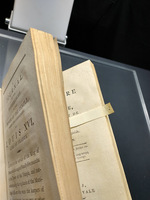
Sammelband: A set of disparate texts, separately printed and later gathered in a single binding. The word is German, meaning literally “gathered volume,” and combining books into a sammelband was quite common during the Middle Ages and early modern period. Unfortunately, Victorian and 20th-century librarians and collectors would often subdivide a sammelband into its constituent parts, destroying valuable information about readers’ history. A sammelband is distinct from a nonce collection in that a true sammelband is created by the book’s owner whereas a nonce collection is produced by the publisher.
Image: French revolutionary tracts. 1756-1835. DC141 .R4
Sammelband: A set of disparate texts, separately printed and later gathered in a single binding. The word is German, meaning literally “gathered volume,” and combining books into a sammelband was quite common during the Middle Ages and early modern period. Unfortunately, Victorian and 20th-century librarians and collectors would often subdivide a sammelband into its constituent parts, destroying valuable information about readers’ history. A sammelband is distinct from a nonce collection in that a true sammelband is created by the book’s owner whereas a nonce collection is produced by the publisher.
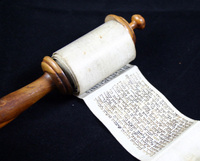
Scroll: A book form, probably developed in ancient Egypt, where the material is written on a continuous strip of material that can be rolled up for storage. Scrolls are still commonly used today in ceremonial and religious contexts: for just two examples, diplomas and Torahs are habitually written as scrolls.
Image: Bible. Ruth. Hebrew. 1400. BS1312.3 1400z
Scroll: A book form, probably developed in ancient Egypt, where the material is written on a continuous strip of material that can be rolled up for storage. Scrolls are still commonly used today in ceremonial and religious contexts: for just two examples, diplomas and Torahs are habitually written as scrolls.
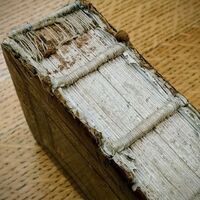
Sewing supports: The cords, thongs, or cloth strips used to connect different gatherings. Gatherings would be sewn onto the sewing supports, which in turn would either be interlaced with the boards or pasted to them. Some bindings draw attention to their sewing supports with raised bands on the outside of the cover, though these may or may not correspond with the actual position of the sewing supports.
Sewing supports: The cords, thongs, or cloth strips used to connect different gatherings. Gatherings would be sewn onto the sewing supports, which in turn would either be interlaced with the boards or pasted to them. Some bindings draw attention to their sewing supports with raised bands on the outside of the cover, though these may or may not correspond with the actual position of the sewing supports.
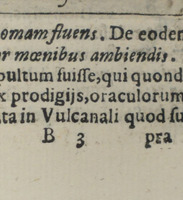
Signature marks: The letters and numerals used to label each gathering, typically on the recto side at the bottom. Each gathering would have a symbol and then some of the sheets would be “signed” with that symbol and a number indicating the leaf. Not every leaf in a gathering is usually signed, but only enough leaves to ensure that there was no chance of misfolding the sheets. For an octavo, for instance, this would likely mean that the first three leaves would be signed, e.g., A1, A2, A3, followed by five unsigned leaves. Most printers would use the 23-letter printer’s alphabet to sign their gatherings, but other symbols might be used as well. The printer's alphabet follows the ancient Roman alphabet in that it does not include the letters J, U, or W. (For those who are interested in alphabetology, “J” is merely the consonantal version of the letter “I,” whereas “U” and “W” are variants on the letter “V.”) If a book had more than 23 gatherings, printers would start over at the beginning, often using two letters rather than one (gathering AA, for instance).
Image: Donati, Alessandro, 1584-1640. Roma vetvs ac recens vtrivsqve aedificiis ad ervditam cognitionem expositis. Rome: Philippus Rubeius, 1665. DG62.5 .D66 1665
Signature marks: The letters and numerals used to label each gathering, typically on the recto side at the bottom. Each gathering would have a symbol and then some of the sheets would be “signed” with that symbol and a number indicating the leaf. Not every leaf in a gathering is usually signed, only enough leaves to ensure that there was no chance of misfolding the sheets. For an octavo, for instance, this would likely mean that the first three leaves would be signed, e.g., A1, A2, A3, followed by five unsigned leaves. Most printers would use the 23-letter printer’s alphabet to sign their gatherings, but other symbols might be used as well. The printer's alphabet follows the ancient Roman alphabet in that it does not include the letters J, U, or W. (For those who are interested in alphabetology, “J” is merely the consonantal version of the letter “I,” whereas “U” and “W” are variants on the letter “V.”) If a book had more than 23 gatherings, printers would start over at the beginning, often using two letters rather than one (gathering AA, for instance).
Sizing: A term for thickened, viscous liquid. Different kinds of sizing are used for a variety of purposes in bookmaking. Historically, the most common sizing was gelatin, usually derived from animal bones, which was used to coat handmade paper to make it stronger and resistant to damage. Seaweed-based sizing is commonly used in paper marbling.
Sophisticated: An adjective for a book that has been altered in order to overcome some of its defects. The most benign form of sophistication is adding missing leaves that have been acquired separately; more unscrupulous collectors and sellers have been known to change a book’s title pages or covers to make it appear rarer. Never suggest an avid collector’s library is sophisticated unless you know they are actively collecting sophisticated copies.
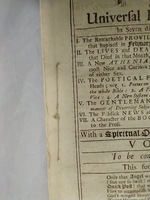
Stab-stitch binding: A binding style where the thread does not go through the fold of the paper but instead stabs through the book from the top to the bottom. In Europe, this was usually reserved for pamphlets and was often a temporary approach; in Asia, it was often used as a more permanent style.
Image: The Post-angel. Printed and are to be sold by A. Baldwin et al., 1702. AP3 .P67 1702
Stab-stitch binding: A binding style where the thread does not go through the fold of the paper but instead stabs through the book from the top to the bottom. In Europe, this was usually reserved for pamphlets and was often a temporary approach; in Asia, it was often used as a more permanent style.
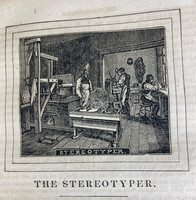
Stereotype: A metal plate that can recreate an entire page of a book, having been made by creating a mold from a page of set type. This is useful because it allows a printer to print the same book over and over again without having to set the type a second time. The mold used to create a stereotype is called a “flong,” which is worth repeating here because it is an amusing word. Stereotyping was invented in 1701 by the Lutheran minister Johann Müller. The use of “stereotype” to refer to an oversimplified and prejudiced image or idea is a reference to stereotype printing.
Image: Hazen, Edward. The panorama of professions and trades or, Every man's book. Philadelphia: U. Hunt, 1836. T47 .H414
Stereotype: A metal plate that can recreate an entire page of a book, having been made by creating a mold from a page of set type. This is useful because it allows a printer to print the same book over and over again without having to set the type a second time. The mold used to create a stereotype is called a “flong,” which is worth repeating here because it is an amusing word. Stereotyping was invented in 1701 by the Lutheran minister Johann Müller. The use of “stereotype” to refer to an oversimplified and prejudiced image or idea is a reference to stereotype printing.

Stub: A piece of paper substantially narrower than a leaf, often just barely protruding from the binding. Stubs may be a sign of a cancel, but they were also sometimes used to allow the insertion of a plate, which could be pasted onto the stub rather than tipped in.
Image: Vitruvius Pollio. Abregé des dix livres d'architecture de Vitruve. Paris: Jean Baptiste Coignard, 1674. NA2515 .V5
Stub: A piece of paper substantially narrower than a leaf, often just barely protruding from the binding. Stubs may be a sign of a cancel, but they were also sometimes used to allow the insertion of a plate, which could be pasted onto the stub rather than tipped in.

Three-quarter bound: A binding style where the spine, part of the boards, and corners are bound in a different material than the rest of the boards. A three-quarter binding differs from a half binding in that a larger percentage of the book’s covers are taken up by the spine and corners. Put another way: a three-quarter binding is a half binding on steroids.
Image: Nicolay, John G. (John George), 1832-1901, and Hay, John, 1838-1905. Abraham Lincoln: A history. New York: The Century Co., 1890. E457 .N653 1890 vol. 1
Three-quarter bound: A binding style where the spine, part of the boards, and corners are bound in a different material than the rest of the boards. A three-quarter binding differs from a half binding in that a larger percentage of the book’s covers are taken up by the spine and corners. Put another way: a three-quarter binding is a half binding on steroids.
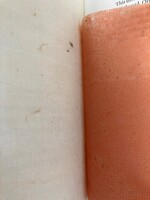
Tipped in: A leaf that has been glued into a book. To tip a leaf in, binders coat one edge of the leaf with adhesive and then tuck the coated edge into the center of the book.
Image: Berger, Sidney E. The handmade papers of Japan: a biographical sketch of its author and an account of the genesis and production of the book. Newtown, PA: Bird & Bull Press, 2001. TS1095 .J3 T52 2001
Tipped in: A leaf that has been glued into a book. To tip a leaf in, binders coat one edge of the leaf with adhesive and then tuck the coated edge into the center of the book.
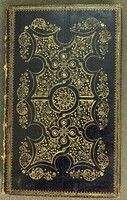
Tooling: Any form of hand decoration in bookbinding, typically using an engraved metal instrument that leaves an image, pattern or groove in the binding material. If the tool in use has been heated, it can be used to press gold leaf into the pattern, resulting in “gold tooling.” Silver tooling using silver foil and other variants also exist. If no material was used, then the resulting pattern is called “blind tooling.” Tooling done on the edges of the book is called gauffering.
Image: Morland, S. (Samuel), Sir, 1625-1695. The doctrine of interest, both simple & compound. London: Printed by Anne Godbid and John Playford, sold by John Playford, 1679. HG1638.E6 M6
Tooling: Any form of hand decoration in bookbinding, typically using an engraved metal instrument that leaves an image, pattern or groove in the binding material. If the tool in use has been heated, it can be used to press gold leaf into the pattern, resulting in “gold tooling.” Silver tooling using silver foil and other variants also exist. If no material was used, then the resulting pattern is called “blind tooling.” Tooling done on the edges of the textblock is called gauffering.
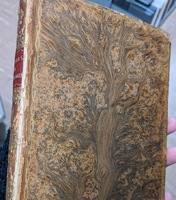
Tree calf: A binding style, popular from the 1770s until the late 1920s, where calfskin leather would be treated with chemicals (ferrous sulfate and potassium carbonate) to form a distinctive branching pattern like a tree or a tree trunk. The result is pretty but also risky: if the leather was not thoroughly washed once the pattern had been burned into it, the ferrous sulfate would continue to eat into the leather until it was eventually ruined.
Image: ʻAbd al-Karim ibn ʻAkibat ibn Muhammad Bulāki, al-kashmīrī. The memoirs of Khojek Abdulkurreem ... who accompanied Nadir Shah, on his return from Hindostan to Persia; from whence he travelled to Baghdad, Damascus, and Aleppo, and after visiting Medina and Mecca, embarked on a ship at the port of Jeddeh, and sailed to Hooghly in Bengal. Including the history of Hindostan, from A.D. 1739 to 1749; with an account of the European settlements in Bengal and on the Coast of Coromandel. Kolkata: W. Mackay, 1788. DS47.5 .A12
Tree calf: A binding style, popular from the 1770s until the late 1920s, where calfskin leather would be treated with chemicals (ferrous sulfate and potassium carbonate) to form a distinctive branching pattern like a tree or a tree trunk. The result is pretty but also risky: if the leather was not thoroughly washed once the pattern had been burned into it, the ferrous sulfate would continue to eat into the leather until it was eventually ruined.

Type: The letters used to print words. Generally, the term refers specifically to moveable type where the letters can be rearranged in any order to print any text. Printing with moveable type was undertaken in Asia as early as the 11th century and was separately invented in Europe in the 15th century by Johannes Gutenberg. A design for a given alphabet is called a “typeface.” A complete set of type in a specific typeface is called a font.
Image: Chinese type.
Type: The letters used to print words. Generally, the term refers specifically to moveable type where the letters can be rearranged in any order to print any text. Printing with moveable type was undertaken in Asia as early as the 11th century and was separately invented in Europe in the 15th century by Johannes Gutenberg. A design for a given alphabet is called a “typeface.” A complete set of type in a specific typeface is called a font.